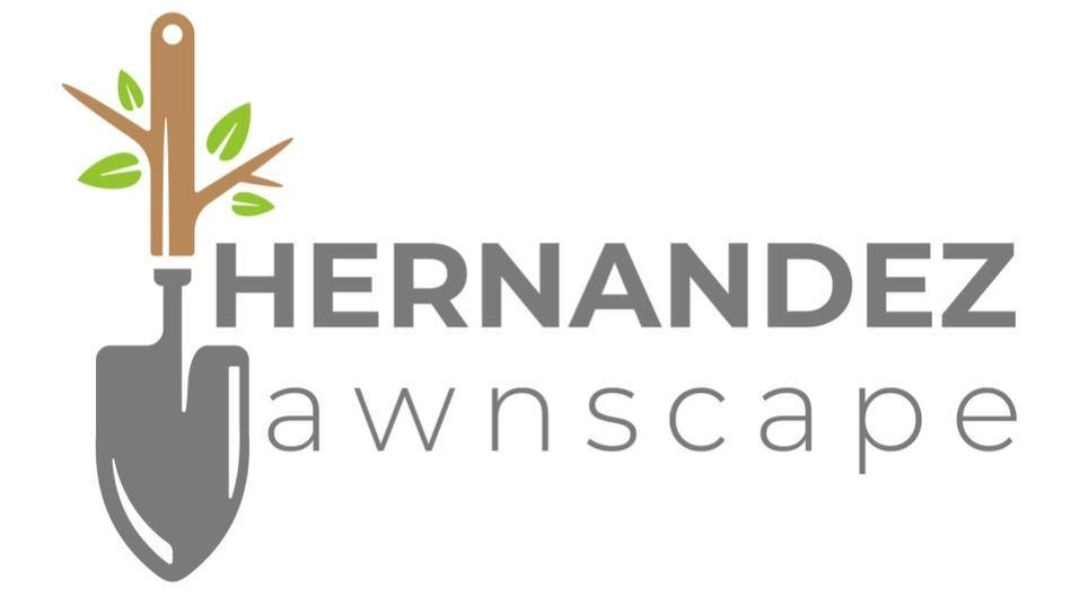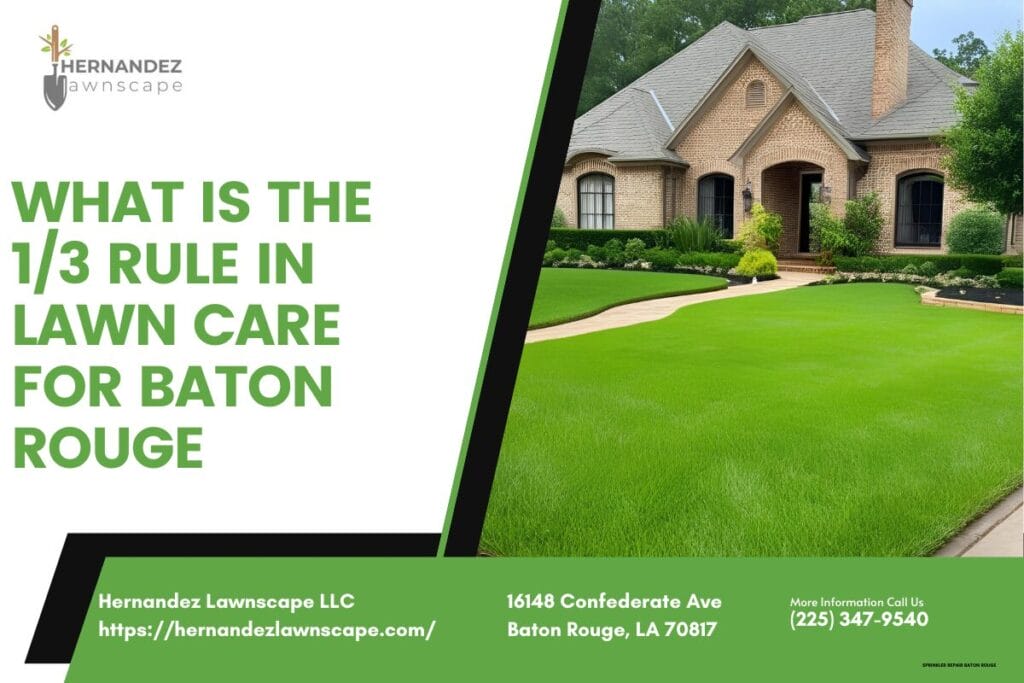The 1/3 rule in lawn care dictates that you should never remove more than one-third of the grass blade’s total height in a single mowing. For Baton Rouge lawns, applying this rule correctly means adapting it as a dynamic strategy to our specific Southern turfgrasses, intense summer heat, and heavy rainy seasons to cultivate a truly resilient and healthy lawn.
Here in Baton Rouge, taking pride in our homes extends to the lush, green carpets that frame them. From the historic Garden District to the sprawling yards in Shenandoah, a beautiful lawn is a hallmark of a well-cared-for property. Many homeowners have heard of a “golden rule of mowing,” often called the 1/3 rule. But at Hernandez Lawnscape, with years of experience managing turf across East Baton Rouge Parish, we know this rule is frequently misunderstood and misapplied in our unique Louisiana climate.
The core thesis we operate by is this: For Baton Rouge lawns, the 1/3 rule is not a static instruction but a dynamic strategy; its true value lies in adapting it to our unique Southern turfgrasses, extreme summer heat, and unpredictable rainy seasons to build a resilient, stress-resistant lawn. Sticking to a rigid number without considering the season or the specific needs of your St. Augustine or Centipede grass can do more harm than good.
What Exactly is the 1/3 Mowing Rule (and What Do Most People Get Wrong)?
At its simplest, the one-third rule for grass cutting is a fundamental principle of turf management. It states that you should never cut off more than the top third of the grass blade at any one time. If your desired mowing height is 2 inches, you should mow your lawn before it gets taller than 3 inches. The concept is so foundational that writers have long referenced it; a 2017 article even ran with the headline ‘The grass is always greener if you follow the rule of 1/3’.
Why is this so important? The grass blade is a plant’s food factory, using photosynthesis to create energy. Cutting off too much at once—a practice known as scalping—sends the plant into shock. It severely reduces its ability to make food, forces it to tap into root reserves, and creates a weak, stressed lawn vulnerable to weeds, pests, and disease. This is how you end up with brown patches after mowing or grass that looks yellow and thin.
Decoding the 1/3 Rule for Your Specific Baton Rouge Turfgrass
Applying the one-third rule effectively starts with knowing the ideal mowing height for your specific type of Southern turfgrass. What works for Bermudagrass will stress St. Augustine. Following the science-backed recommendations from sources like the LSU AgCenter is the foundation of our professional lawn mowing standards.
St. Augustine & Zoysia: The Lush Carpets
These grasses are popular throughout Baton Rouge for their dense, carpet-like growth. They thrive when mowed at a taller height, which helps choke out weeds and protects their runners (stolons).
- Ideal Mowing Height: 2.5 to 3.5 inches for St. Augustine; 2 to 3 inches for Zoysia in south Louisiana.
- Applying the 1/3 Rule: To maintain a lush 3-inch St. Augustine lawn, you must mow it when the grass reaches 4.5 inches. Letting it grow to 6 inches and then cutting it back to 3 means you’ve removed 50% of the blade, violating the rule and causing significant stress.
Centipede & Bermudagrass: The Sun Worshippers
Often found in sunnier lawns, these grasses can be maintained at a lower height. Bermudagrass, in particular, is incredibly well-suited for our climate. In fact, its key strengths include drought tolerance and heat tolerance, making it a tough contender in a Louisiana summer.
- Ideal Mowing Height: 1.5 to 2.5 inches for Centipede. For Bermudagrass, the recommended mowing height for home lawns is 1 to 2 inches.
- Applying the 1/3 Rule: If your target for a Bermudagrass lawn is 1.5 inches, you need to be cutting it before it exceeds 2.25 inches. This often requires more frequent mowing during the active spring and summer growth seasons to maintain healthy turfgrass in Louisiana.
Adapting the Rule: Your Strategy for Baton Rouge’s Climate
Understanding your grass type is step one. Step two is adjusting your mowing practices based on our city’s challenging weather patterns. This is where true craftsmanship and lawn care expertise shine.
The ‘Summer Stress’ Adjustment: Mowing High for Survival
When the summer sun is beating down and temperatures are consistently in the 90s, your lawn is under immense stress. The best defense is to adjust your mower deck height. During peak heat (typically June through August in Baton Rouge), we recommend mowing at the highest end of the recommended range for your grass type. A 3.5-inch St. Augustine lawn will be far more resilient than one cut at 2.5 inches. The taller blades provide more shade for the soil, reducing water evaporation and keeping the root zone cooler. This simple seasonal mowing adjustment promotes deeper root growth, which is your lawn’s primary defense against drought.
As one of our clients noted, “I could not be more pleased with Hernandez Lawnscape. Excellent service all around…5 stars!” This level of satisfaction comes from our team’s deep understanding of these crucial seasonal adjustments.
The ‘Rainy Week Recovery’ Method: Taming the Jungle
We’ve all seen it: a week of relentless thunderstorms leaves the lawn looking like a jungle. The temptation is to drop the mower deck low and get it done in one pass. This is one of the fastest ways to damage your lawn. If turfgrasses are not mowed frequently enough, they may lose density and overall health. A drastic cut on an overgrown lawn is a recipe for disaster.
Instead, follow this safe, step-by-step recovery method:
- Resist the Scalping Urge: Do not cut the lawn back to its normal height in one go.
- Make the First Pass High: Set your mower to its highest cutting setting. Mow the entire lawn. This might only remove the very top of the blades, and that’s okay. The goal is to reduce the volume without shocking the plant.
- Wait and Observe: Give the lawn 2-3 days to recover from the initial cut.
- Make a Second, Lower Pass: Lower your mower deck by about one-third of the remaining excess height and mow again. For example, if the lawn is now 5 inches tall and your target is 3 inches, you might set the deck to 4 inches for this second pass.
- Repeat if Necessary: Continue this process every few days until you have safely returned the lawn to its ideal maintenance height.
Beyond the Cut: How the 1/3 Rule Powers Grasscycling in Baton Rouge
Mastering the one-third rule unlocks one of the best practices for a healthy local ecosystem: Grasscycling. This is the simple act of leaving your grass clippings on the lawn after mowing. The City of Baton Rouge actively encourages this practice to reduce waste in our landfills.
The 1/3 rule is the key to successful grasscycling. When you only remove a small portion of the grass blade, the clippings are short, light, and decompose quickly. They fall between the blades of grass and return valuable nitrogen and moisture to the soil, acting as a free, natural fertilizer. However, if you violate the rule and cut off half the grass blade, you’re left with long, wet clumps that smother the turf, block sunlight, and can promote fungal diseases.
For best results, ensure you have sharp mower blades. A sharp blade makes a clean cut, which helps the grass heal faster and allows the small clippings to be mulched effectively. It’s a small detail that makes a big difference. Many clients appreciate this attention to detail, with one saying, “They always go a step beyond what I expect and consistently provide excellent service.”
Frequently Asked Questions from Baton Rouge Residents
What time can I legally start mowing in Baton Rouge?
While specific rules can vary by neighborhood covenants, the general City of Baton Rouge noise ordinance for residential areas permits this kind of activity starting around 7:00 AM on weekdays. However, as a matter of professional courtesy and for the health of your lawn, we advise against it. Mowing when there’s heavy dew on the grass can lead to an uneven cut and promote the spread of fungus. The best time of day to mow in Baton Rouge is typically mid-morning, from about 9 AM to 11 AM, after the dew has evaporated but before the intense afternoon heat sets in.
How do professionals determine lawn care charges?
This is a complex question because professional lawn care is much more than just a quick cut. Pricing is determined by a variety of factors: the square footage of the turf, the complexity of the property (slopes, obstacles), sidewalk and driveway edging, blowing off hardscapes, and the specific needs of the turf. Most importantly, you are paying for the expertise to apply dynamic strategies like the 1/3 rule correctly throughout the seasons, ensuring your lawn’s long-term health and beauty, not just a temporary trim.
Making the Right Choice for Your Needs
Understanding the 1/3 rule is one thing; applying it consistently in Baton Rouge’s demanding climate is another. The best approach depends entirely on your goals, time, and knowledge.
- For the DIY Homeowner: You take pride in your work but may find your lawn struggling during our extreme weather. Our advice is to treat the 1/3 rule as a flexible guide, not a rigid law. Be prepared to increase your mowing frequency during the fast-growing spring season and raise your mower height during the summer. Your biggest challenge will be consistency, especially after a rainy week. Don’t be afraid to perform a multi-day recovery cut to avoid damaging months of hard work.
- For the Hands-Off Property Owner: Your time is valuable, and you expect professional results without needing to know the technical details. You don’t need to measure grass blades; you need to hire a team that does. When choosing a lawn service, ask them how they adjust their practices for summer heat or rainy periods. A true professional will explain their strategy for avoiding lawn stress, and their results will speak for themselves.
- For the New Baton Rouge Resident: Welcome to Louisiana! If you’ve moved from a different climate, you’ve probably discovered that the lawn care practices that worked on fescue or bluegrass are ineffective on our Southern turf. Our advice is to first identify your grass type—likely St. Augustine or Centipede. Then, learn its specific needs. The biggest mistake is cutting our warm-season grasses too short, which is a common practice up north. Consulting a local expert can save you a season of frustration and help you build a beautiful lawn from the start.
Ultimately, applying the 1/3 rule is about more than just numbers; it’s about a commitment to the health and resilience of your lawn. It’s a craft that combines horticultural science with a deep understanding of the local Baton Rouge environment. For a lawn that reflects your pride of ownership and a team that brings this expert, localized approach to every property, contact Hernandez Lawnscape today. We’ll provide a comprehensive assessment and a free, no-obligation quote to help you create the beautiful, functional outdoor space you deserve.






